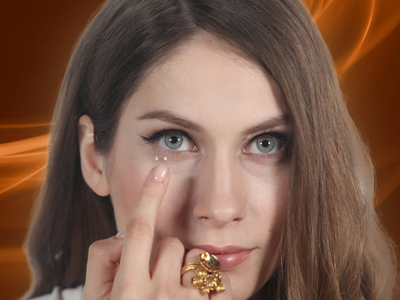Contact lens fitting and aftercare
Xenophontos Opticians offer professional contact lens fitting and aftercare services for all types of contact lenses. Contact lenses offer a fantastic alternative to glasses and if you haven’t tried them before, you will immediately agree once you’ve had them in your eyes, that these ‘little visual wonders’ free you from the limitations of a spectacle frame and offer you new horizons of freedom to enjoy life.
Whether you are shortsighted or longsighted, astigmatic or presbyobic (or even most of all these things together at the same time!), whether you need contact lenses for sports or just dislike being behind your spectacles all day long, there is a suitable pair of contact lenses just for you. Contact lens design and technology has evolved dramatically over the last few decades and that means that almost all spectacle wearers are suitable for contact lenses.
Initial contact lens consultation
During your first contact lens consultation, your Optometrist will explain the different types of contact lenses available for your individual prescription. There are further different factors that contribute to the exact and final type of contact lens to be prescribed for you, such as desired pattern of wear and desired wearing schedule. The contact lens cost as well as the cost of contact lens maintenance will be explained in detail. It is worth mentioning, that at Xenophontos Opticians the first pair of soft contact lenses is always dispensed complimentary if you are a new contact lens wearer, so you can give your lenses a test run before actually investing in your first contact lens supply.
Examining the external part of the eye is essential during your first contact lens consultation and most definitely during all your contact lens aftercare visits. During this procedure, you will be asked to gently rest your head behind an instrument called a slit lamp, and factors like tear production and quality, eyelid health and hygiene and cornea health and clarity will be closely examined. The necessary measurements of the front of your eye will be taken and noted using another instrument called a keratometer.
Contact lenses will be initially inserted in your eyes by your optometrist and once all relevant factors have been checked, such as your corrected vision and how the contact lenses actually fit on your eyes, you will be guided in detail, always by your Optometrist again, through the entire procedure of contact lens handling and contact lens care. Be sure that you will leave your very first contact lens consultation appointment having the knowledge and the confidence of an experienced contact lens wearer. You will know how contact lenses should feel like and will be able to take care of them ensuring that your eye health is always kept at tip top condition. Remember that experience contact lens fitters definitely agree on the fact that contact lenses DO NOT cause any problems at all, as long as you use them and you take care of them correctly.
Aftercare contact lens visits
It is important to know that becoming a contact lens wearer means that it is vital to visit your Optometrist as often as instructed in order to ensure that eye health is kept as its best. More specifically, the first aftercare appointment for almost all types of contact lenses, takes place two weeks after you receive your first pair of lenses. Furthermore, teenagers are usually advised to keep contact lens appointments every six months whereas adults should visit their Optometrist for a contact lens appointment at least once a year. Please attend all routine aftercare contact lens appointments wearing your contact lenses at least one hour before the scheduled appointment time, and always try if possible to also have with you your spectacles as well as your contact lens case.
All types of contact lenses fitted including:
- Soft contact lenses e.g: daily disposables, frequently replacement soft contact lenses
- Rigid Gas Permeable contact lenses, usually used for high astigmatic prescriptions
- Special fitting contact lenses: required for example when ectatic eye conditions of the cornea are present such as keratoconus, or required following special types of eye surgery such as refractive surgery or even corneal transplant



